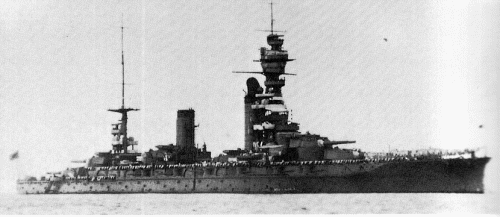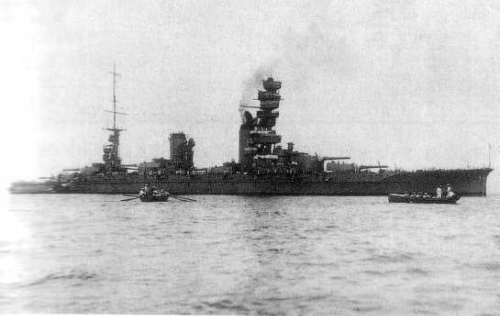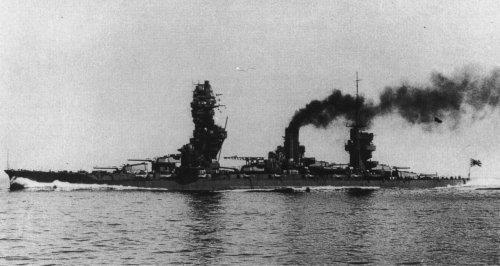
NAVYPEDIA
 Support the project with paypal
Support the project with paypal
Photo
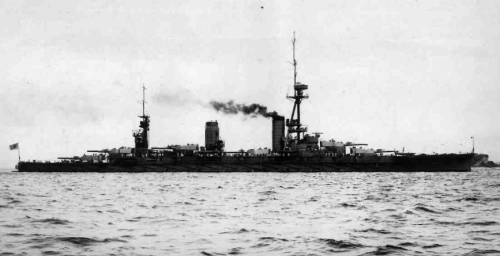
Yamashiro
Ships
| Name | No | Yard No | Builder | Laid down | Launched | Comp | Fate |
|---|---|---|---|---|---|---|---|
| 扶桑 [Fuso] | Kure K K | 11.3.1912 | 28.3.1914 | 18.11.1915 | sunk 25.10.1944 | ||
| 山城 [Yamashiro] | Yokosuka K K | 20.11.1913 | 3.11.1915 | 31.3.1917 | sunk 25.10.1944 |
Technical data
| Data variant | as completed | 1938 after modernization |
|---|---|---|
| Displacement standard, t | --- | 34700 |
| Displacement normal, t | Fuso: 30600 Yamashiro: 34700 |
|
| Displacement full, t | Fuso: 35900 Yamashiro: 39154 |
39154 |
| Length, m | 202.7 wl 205.1 oa |
210.0 wl 212.8 oa |
| Breadth, m | 28.7 |
30.6 wl (33.1 max) |
| Draught, m | 8.70 |
9.69 |
| No of shafts | 4 |
4 |
| Machinery | 4 Brown-Curtis steam turbines, 24 Miyabara boilers |
4 sets Kampon geared steam turbines, 6 Kampon boilers |
| Power, h. p. | 40000 |
75000 |
| Max speed, kts | 22.5 |
24.7 |
| Fuel, t | coal 5022 + oil 1026 |
oil 5100 |
| Endurance, nm(kts) | 8000(14) | 8000(16) |
| Armour, mm | belt: 305 - 102, bulkheads: 305 - 102, deck: 76 - 30, barbettes: 305 - 203, turrets: 305 - 203, casemates: 152, CT: 350, director: 152 |
belt: 305 - 102, bulkheads: 305 - 102, main deck: 97, upper deck: 51 - 32, barbettes: 305 - 203, turrets: 305 - 114, casemates: 152, CT: 350 |
| Armament | 6 x 2 - 356/45 41-shiki, 16 x 1 - 152/50 41-shiki, 12 x 1 - 76/40 41-shiki, 6 - 533 TT (beam) |
6 x 2 - 356/45 41-shiki, 14 x 1 - 152/50 41-shiki, 4 x 2 - 127/40 89-shiki, 8 x 2 - 25/60 96-shiki, 1 catapult, 3 seaplanes (E4N2) |
| Complement | 1193 |
1396 |
Standard scale images
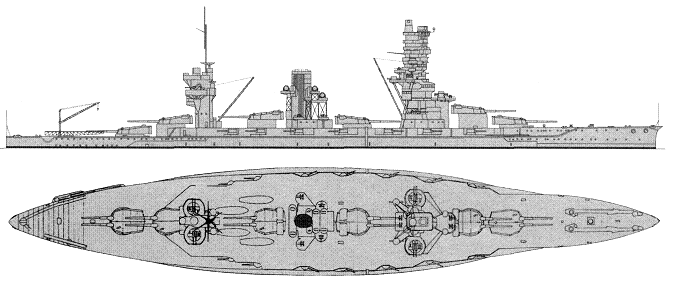
Fuso 1941

Yamashiro 1944

Yamashiro 1917

Fuso 1939
Graphics
Project history
Fuso and Yamashiro were built under the 1911 Programme. Design has been created on the basis of the drawings of British-designed battlecruiser Kongo; it was designated A-64 by Japanese Navy. Relatively big length was needed to accommodate 6 twin 356mm turrets; the Vickers files show that designs for triple turrets (at least in 305mm calibre) were available to the Japanese, so that the choice of twins must have been deliberate. A postwar Japanese account suggested that it was superior in attack, whereas the US triple system was superior in defence. That may mean that a ship with six individual turrets would be better able to deal with multiple targets. Thus Japanese designers have significantly redesigned it according to the point of view dominating on the eve of the First World War, that the battleship at the expense of smaller, in comparison with a battlecruiser, speed should have stronger armament and protection. Having moderated machinery power, in comparison with a prototype, more than on third (40000hp in comparison with 64000) and having shorter and wider hull, it was possible to raise number of main guns from 8 to 12 and significantly strengthen protection, increasing thickness of main belt and turret faces to 305mm in comparison with 203-229mm on Kongo. Protection scheme repeated accepted on the first Japanese dreadnoughts. The protection weight was 8588t, on 2000t more than on a prototype. The armament consisted from 12 356mm guns (the same model, as on battlecruisers), placed in six twin turrets from which two were positioned amidships and had the limited angles of raking. Main guns were supplemented by 16 152mm secondary guns in casemates and 6 submerged 533mm TT.
Though at the moment of completing Fuso class battleships were the largest warships in the world, after some years, after an adoption of a program "8-8" they were recognised as become outdated and have scheduled to be stricken by 1928. They were saved by Washington conference of 1922, according to which decisions the implementation of a program "8-8" has been cancelled and "battleship vacation" was declared, and value of complete battleships has raised multiply.
Ship protection
3.8m-high main belt extended from No1 to No6 barbettes and had 305mm thickness between barbettes, tapering to 102mm at lower edge. It closed by same bulkheads abreast end barbettes. Hull outside end barbettes was protected by 203mm belt tapered to 102mm at lower edge, thickness of this belt decreased to 102mm near ship ends. Upper 203mm belt extended from main belt to upper deck and from No1 to No6 barbette. It was closed by 127mm bulkheads. Casemates had 152mm armor. Flat main 32mm deck connected with upper edge of main belt. Its thickness increased to 51mm outside end barbettes and 76mm over steering gear. Upper deck between end barbettes had 35mm thickness. Forecastle deck over casemates was 19mm. Turrets had 305mm faces, 203mm sides and 114mm crowns. Fore CT had 350mm sides and aft CT had 152mm.
Ship protection after modernization: 3.8m-high main belt extended from No1 to No6 barbettes and had 305mm thickness between barbettes, tapering to 102mm at lower edge. It closed by same bulkheads abreast end barbettes. Hull outside end barbettes was protected by 203mm belt tapering to 102mm at lower edge, thickness of this belt decreased to 102mm near ship ends. Upper 203mm belt extended from main belt to upper deck and from No1 to No6 barbette. It was closed by 127mm bulkheads. Casemates had 152mm armor. Flat main 97mm deck connected with upper edge of main belt. Its thickness decreased to 51mm outside end barbettes and 76mm over steering gear. Upper deck between end barbettes had 35mm thickness. Forecastle deck over casemates was 19mm. Turrets had 305mm faces, 203mm sides and 114mm crowns. Fore CT had 356mm sides and aft CT had 152mm.
Modernizations
1918, both: - 12 x 1 - 76/40; + 4 x 1 - 76/40 3-shiki AA
1923 - 1924, both: superstructure was reconstructed, main guns elevation angle increased from 25° to 30°; + 2 x 1 - 76/40 3-shiki
1922, Yamashiro: + flying-off platform (temporarily till 1923)
(4/1930 - 9.1932 Yokosuka KK, 9.1932 - 5.1933 Kure K K) Fuso: fully new machinery was fitted, deck armor was strengthened up to 97mm. New 63-37mm longitudinal anti-torpedo bulkhead and bulges were installed, breadth increased to 30.6m wl (33.1m max). Main guns elevation angle rose to 43° and secondary guns to 30°. - 2 x 1 - 152/50, 6 x 1 - 76/40; + 4 x 2 - 127/40 89-shiki, some 13.2/76 MGs. Fore funnel was removed. Superstructure was reconstructed again.
(9/1934 - 3.1935 Kure K K) Fuso: hull was lengthened, maximal speed increased.
(12/1930 - 3.1935 Sasebo K K) Yamashiro: fully new machinery was fitted, deck armor was strengthened up to 97mm. New 63-37-mm longitudinal anti-torpedo bulkhead and bulges were installed, breadth increased to 30.6m wl (33.1m max). Main guns elevation angle rose to 43° and secondary guns to 30°. - 2 x 1 - 152/50, 6 x 1 - 76/40; + 4 x 2 - 127/40 89-shiki, some 13.2/76 MGs. Fore funnel was removed. Super structure was reconstructed again, hull was lengthened, maximal speed increased.
3/1938, both: - 13.2-mm MGs; + 8 x 2 - 25/60 96-shiki. Data was as given in the table.
7/1943, both: + 2 x 2 - 25/60 96-shiki, 17 x 1 - 25/60 96-shiki, 1-shiki 2-go radar
8/1944, Fuso: + 8 x 3 - 25/60 96-shiki, 6 x 2 - 25/60 96-shiki, 10 x 1 - 13.2/76, 2x 3-shiki 1-go, 2x 2-shiki 2-go radars
8/1944, Yamashiro: - 1 x 2 - 25/60; + 8 x 3 - 25/60 96-shiki, 7 x 1 - 25/60 96-shiki, 24 x 1 - 13.2/76, 2x 3-shiki 1-go, 2x 1-shiki 2-go, 2x 2-shiki 2-go radars
10/1944, Fuso: + 22 x 1 - 25/60 96-shiki
10/1944, Yamashiro: - 14 x 1 - 13.2/76; + 8 x 2 - 25/60 96-shiki, 10 x 1 - 25/60 96-shiki, 3 x 2 - 13.2/76
Naval service
Both battleships were sunk in night battle in Surigao Strait 25.10.1944. Fuso was attacked by SB2C diving bombers from US carriers Enterprise and Franklin (1 hit of 454kg bomb) 24.10.1944, and was hit by 1 or 2 torpedoes from US destroyer Melvin day after. She has blown up and broken apart, both parts some time were afloat. Yamashiro was hit by torpedo from US destroyer Monssen and torpedo from US destroyer Killen, later she was badly damaged by gunfire of USN battleships Maryland, Mississippi, West Virginia, Tennessee, California, Pennsylvania (many hits of 356mm and 406mm shells) and cruisers and sunk by 2 torpedoes from USN destroyer Newcomb.
 HOME
HOME FIGHTING SHIPS OF THE WORLD
FIGHTING SHIPS OF THE WORLD JAPAN
JAPAN CAPITAL SHIPS
CAPITAL SHIPS FUSO battleships (1915 - 1917)
FUSO battleships (1915 - 1917)